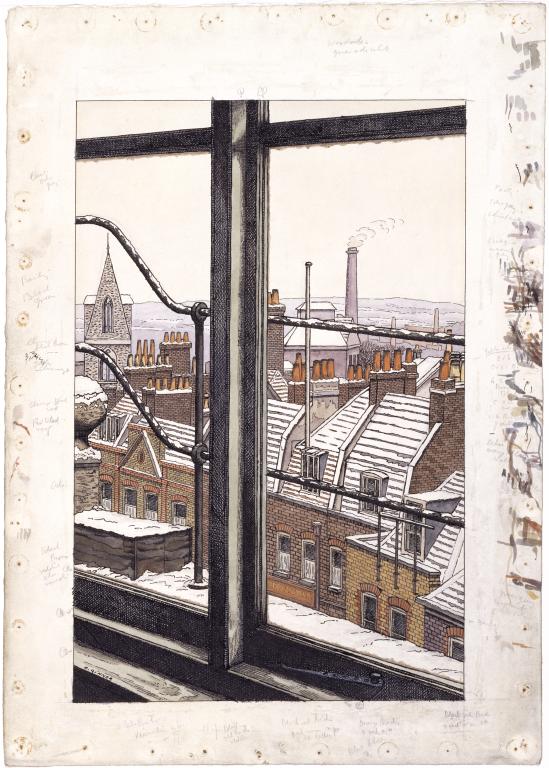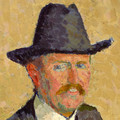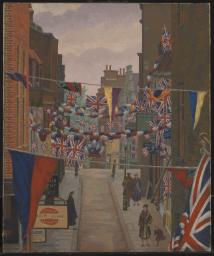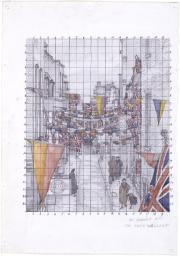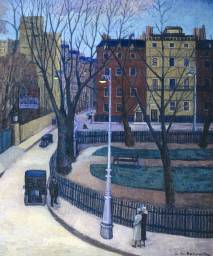Charles Ginner From a Hampstead Window 1923
Charles Ginner,
From a Hampstead Window
1923
Ginner’s watercolour shows a reversed view, as seen in a mirror, of Hampstead in north London after a fall of snow. Using pen and ink and watercolour in soft browns and purples, Ginner has drawn the buildings in great detail, carefully articulating each individual brick.
Charles Ginner 1878–1952
From a Hampstead Window
1923
Ink, watercolour and graphite on paper
443 x 314 mm
Inscribed ‘C. GINNER’ in ink bottom left
Purchased (Duveen Drawings Fund) 1924
N03873
1923
Ink, watercolour and graphite on paper
443 x 314 mm
Inscribed ‘C. GINNER’ in ink bottom left
Purchased (Duveen Drawings Fund) 1924
N03873
Ownership history
Purchased from the artist for 12 guineas (£12 12s) via the Goupil Gallery, London, 1924.
Exhibition history
1924
Oil Paintings, Water-Colours and Drawings by Charles Ginner, Louise Pickard and Ethel Walker, Goupil Gallery, London, January 1924 (60, 12 guineas).
1938
Empire Exhibition, Palace of Fine Arts, Glasgow 1938 (401).
1953–4
Charles Ginner 1878–1952, (Arts Council tour), Darlington Art Gallery, November 1953, Bristol Art Gallery, November–December 1953, Carlisle Art Gallery, January 1954, Tate Gallery, London, January–February 1954, Southampton Art Gallery, February–March 1954, Assembly House, Norwich, March–April 1954 (31).
1968–9
Royal Academy of Arts Bicentenary Exhibition, Royal Academy, London, December 1968–March 1969 (629).
References
1924
Colour, August 1924, p.24.
1958
Twentieth Century British Water-colours from the Tate Gallery and the Victoria and Albert Museum, exhibition catalogue, Victoria and Albert Museum, London 1958, reproduced pl.11.
1964
Mary Chamot, Dennis Farr and Martin Butlin, Tate Gallery Catalogues: The Modern British Paintings, Drawings and Sculpture, vol.1, London 1964, p.239.
Technique and condition
From a Hampstead Window is executed in pen and ink and watercolour on wove paper. The off-white paper is textured and appears to be of good quality, appropriate for a finished drawing intended for display. There are numerous pin holes along all four of the edges made by drawing pins. The function of these is not known but it is possible that Ginner used pins to secure the paper to a drawing board and/or attached threads to the pins to create plumb lines to measure the angles of the strong horizontal, vertical and diagonal lines of the composition. The image is centred on the sheet and drawn within a square measuring 350 x 230 mm. Faint graphite lines are visible in areas where the artist has altered the position of certain elements, such as the church steeple. The outlines of the main forms are drawn in pen and black ink, with cross-hatching lines to indicate areas of shadow. Watercolours are generally confined within the outlined shapes and are evenly applied as solid blocks of colour. There are numerous pencil annotations and touches of watercolour in the right-hand margin made by the artist to blot the brush and test the colours and ensure that they were correct when applied to the image. The image is in good condition. The watercolour was surface cleaned, washed, pressed and the mount replaced in 1992.
Tomoko Kawamura
June 2005
How to cite
Tomoko Kawamura, 'Technique and Condition', June 2005, in David Fraser Jenkins, ‘From a Hampstead Window 1923 by Charles Ginner’, catalogue entry, May 2005, in Helena Bonett, Ysanne Holt, Jennifer Mundy (eds.), The Camden Town Group in Context, Tate Research Publication, May 2012, https://wwwEntry
Ginner exhibited watercolours at the Goupil Gallery in January 1924; this one was made just before that exhibition after a fall of snow. In his second notebook it is recorded as the last item made in 1923, and so was likely to have been drawn in December.1 It is a finished watercolour for display, not a preparatory drawing for a painting. Painted from a mirror, it shows a reversed view of Hampstead as seen from the attic of 61 Hampstead High Street, the address where Ginner lived from 1919 to 1938.
The wide margins of the paper are full of colour notes, some of them linked to numbered places on the edge of the picture. On the right these are partly covered with dabs of watercolour, where Ginner was blotting the brush or testing colours as the picture was painted. The colour notes indicate Ginner’s particular interest in bricks and chimneys. although they are difficult to read and the words in this list might not all be accurate. At the top it reads:
[?]woodwork | green ochre white
Running down the left-hand side:
[?]church | ochre | grey
Railing | Black | green
chimneys | black brown
yellow | chimneys
Chimneys Black | red
Redtiled | roof
Ochre
Black | Brown | reddish | ochre | variation
Railing | Black | green
chimneys | black brown
yellow | chimneys
Chimneys Black | red
Redtiled | roof
Ochre
Black | Brown | reddish | ochre | variation
At the bottom of the paper:
Ochre ... | vermilion
Black | red brick | redder
Black red bricks | red verm[ilion] sign | and ... letters
Orange Bricks | red [?]& w.
Black ochre
Black red Bricks | and red [?]& w.
Black | red brick | redder
Black red bricks | red verm[ilion] sign | and ... letters
Orange Bricks | red [?]& w.
Black ochre
Black red Bricks | and red [?]& w.
And running down the right-hand side:
Factory | blue grey | ochre wall
Background | ... | grey
Yellow chim[ney]
2/3 | O.O.B
4 C ... | Brown | Black
5 ochre | ...
6 Red Black
7 ditto
Ochre | orange, black | wall
viridian | green grey | woodwork | white ochre
Background | ... | grey
Yellow chim[ney]
2/3 | O.O.B
4 C ... | Brown | Black
5 ochre | ...
6 Red Black
7 ditto
Ochre | orange, black | wall
viridian | green grey | woodwork | white ochre
The railings as seen from Ginner’s window are there today just as in the watercolour, and one building in the street is the same.2 The church spire belonged to Trinity Presbyterian Church, which has been demolished. The work appears to have been drawn accurately, but then the whole image – window, railings and view – are reversed from left to right, as if a preparatory drawing had been turned upside down and a copy made. This was noted in the 1964 Tate Gallery catalogue.3 Responding to the Assistant Keeper Mary Chamot’s queries, Ginner’s sister Ruby Ginner Dyer replied:
His book does not say whether it was painted from a mirror, and I do not remember the picture – I know he amused himself sometimes by changing things to make a better composition, and I remember his saying to me once ‘If I don’t like the place where God put the hill, I pick the hill up and put it somewhere else to make a good picture’! He may have done that in the case of the church and the chimney! I don’t know.4
The reference in Colour magazine for the summer of 1924 shows that the watercolour was then on display at the Tate Gallery. The author described it as a welcome appearance of modern art at the gallery:
The Tate Gallery is coming more and more up to date. On a recent hurried visit we noticed in what has been called the Bolshevist Room, a water-colour by Charles Ginner – a recent acquisition, if we are not mistaken, and done in the customary detailed Ginner method.5
Ginner often included the window and window-sill in his views. His oil painting Roof Tops (Harris Museum and Art Gallery, Preston),6 for example, includes a similar window and guard rail in front of a view of a different town.
David Fraser Jenkins
May 2005
Notes
Tate Archive TGA 9319/2, p.123. The drawing listed two before this work is entitled Hampstead Roofs, Frost.
Mary Chamot, Dennis Farr and Martin Butlin, Tate Gallery Catalogues: The Modern British Paintings, Drawings and Sculpture, vol.1, London 1964, p.239.
Mrs Ruby Ginner Dyer, letter to Mary Chamot, 15 August 1957, Tate Catalogue file. In her next letter of 22 August she offered the Tate ‘sheaves’ of his press cuttings ‘back to the beginning of his work’, but Chamot did not respond.
Related biographies
Related catalogue entries
How to cite
David Fraser Jenkins, ‘From a Hampstead Window 1923 by Charles Ginner’, catalogue entry, May 2005, in Helena Bonett, Ysanne Holt, Jennifer Mundy (eds.), The Camden Town Group in Context, Tate Research Publication, May 2012, https://www

